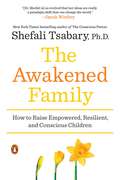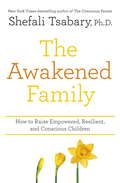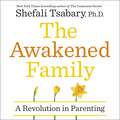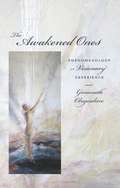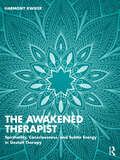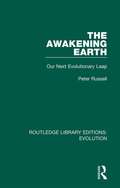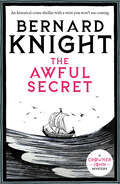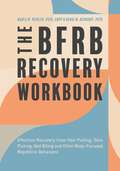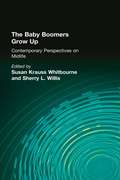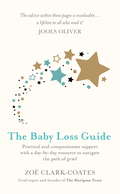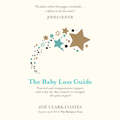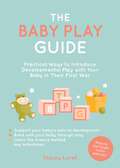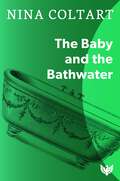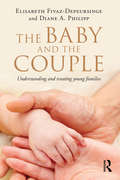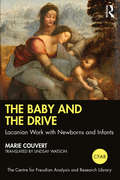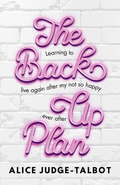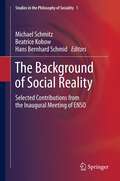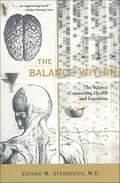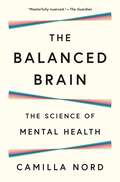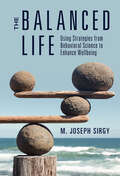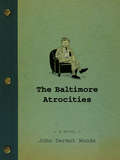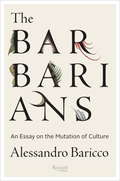- Table View
- List View
The Awakened Family: A Revolution in Parenting
by Shefali Tsabary"Parents . . . you will be wowed and awed by [Dr. Shefali]." --Oprah WinfreyNew from the New York Times bestselling author of The Conscious Parent comes a radically transformative plan that shows parents how to raise children to be their best, truest selves.What if...? What if I told you that you can put an end to all of your parenting struggles? That you can learn to parent without fear or anxiety? That you can end conflict with your children? That you can create close and connected relationships within your family? ...Would you accept this invitation to a revolution in parenting? We all have the capacity to raise children who are highly resilient and emotionally connected. However, many of us are unable to because we are blinded by modern misconceptions of parenting and our own inner limitations. In The Awakened Family, I show you how you can cultivate a relationship with your children so they can thrive; moreover, you can be transformed to a state of greater calm, compassion and wisdom as well. This book will take you on a journey to transcending your fears and illusions around parenting and help you become the parent you always wanted to be: fully present and conscious. It will arm you with practical, hands-on strategies and real-life examples from my experience as a parent and clinical psychologist that show the extraordinary power of being a conscious parent. Everyone in your family is ready to be awakened. Will you take this journey with me?--ShefaliFrom the Hardcover edition.
The Awakened Family: How to Raise Empowered, Resilient, and Conscious Children.
by Dr Shefali Tsabary'Parents ... you will be wowed and awed by [Dr. Shefali].' - Oprah WinfreyBecome the awakened parent you've always wanted to be and watch your children thrive.All parents have aspirations for their children but for some these hopes turn into unrealistic expectations. In many cases, this puts huge amounts of pressure on children and has the potential to cause real harm, hindering your child's development. Challenging modern myths on how kids should be, Dr Shefali helps parents recognise children for who they truly are instead of holding onto society's impossible ideals.Drawing on Eastern philosophy as well as Western psychology, Dr Shefali offers enlightened, practical advice and explains her radically transformative plan which guarantees that you have confident children and a calm and emotionally connected family.
The Awakened Family: How to Raise Empowered, Resilient, and Conscious Children.
by Dr Shefali TsabaryDr Shefali teaches us how to control our expectations, embrace the present moment, and let go of the anxiety surrounding how best to parent our children.Become the awakened parent you've always wanted to be and watch your children thrive.All parents have aspirations for their children but for some these hopes turn into unrealistic expectations. In many cases, this puts huge amounts of pressure on children and has the potential to cause real harm, hindering your child's development. Challenging modern myths on how kids should be, Dr Shefali helps parents recognise children for who they truly are instead of holding onto society's impossible ideals.Drawing on Eastern philosophy as well as Western psychology, Dr Shefali offers enlightened, practical advice and explains her radically transformative plan which guarantees that you have confident children and a calm and emotionally connected family.(P)2017 Penguin Random House Audio
The Awakened Ones: Phenomenology of Visionary Experience
by Gananath ObeyesekereWhile a rational consciousness grasps many truths, Gananath Obeyesekere believes an even richer knowledge is possible through a bold confrontation with the stuff of visions and dreams. Spanning both Buddhist and European forms of visionary experience, he fearlessly pursues the symbolic, nonrational depths of such phenomena, reawakening the intuitive, creative impulses that power greater understanding.Throughout his career, Obeyesekere has combined psychoanalysis and anthropology to illuminate the relationship between personal symbolism and religious experience. In this book, he begins with Buddha's visionary trances wherein, over the course of four hours, he witnesses hundreds of thousands of his past births and eons of world evolution, renewal, and disappearance. He then connects this fracturing of empirical and visionary time to the realm of space, considering the experience of a female Christian penitent, who stares devotedly at a tiny crucifix only to see the space around it expand to mirror Christ's suffering. Obeyesekere follows the unconscious motivations underlying rapture, the fantastical consumption of Christ's body and blood, and body mutilation and levitation, bridging medieval Catholicism and the movements of early modern thought as reflected in William Blake's artistic visions and poetic dreams. He develops the term "dream-ego" through a discussion of visionary journeys, Carl Jung's and Sigmund Freud's scientific dreaming, and the cosmic and erotic dream-visions of New Age virtuosos, and he defines the parameters of a visionary mode of knowledge that provides a more elastic understanding of truth. A career-culminating work, this volume translates the epistemology of Hindu and Buddhist thinkers for western audiences while revitalizing western philosophical and scientific inquiry.
The Awakened Therapist: Spirituality, Consciousness, and Subtle Energy in Gestalt Therapy
by Harmony KwikerThe Awakened Therapist is an accessible introduction to gestalt therapy through the lens of transpersonal counseling, one that offers a clear and profound account of how to bridge the gap between traditional counseling and spiritual transformation. Bringing new depths to the art of therapy, Harmony Kwiker provides a map for therapists to dismantle the old paradigm of therapist-as-expert and honor their clients’ innate wisdom. The chapters seamlessly weave together elusive concepts of levels of awareness, subtle energy, and spiritual alignment with psychological concepts that are embedded in the theory and application of gestalt therapy. After reading this book, therapists will be inspired and energized while having more substantial breakthroughs with their clients.
The Awakening Earth: Our Next Evolutionary Leap (Routledge Library Editions: Evolution #11)
by Peter RussellOriginally published in 1982 The Awakening Earth explores the idea of the Earth as a collective, self-regulatory living organism, and considers in this context, the function of the human race. The book provides an exploration of humanity’s potential and explores the possibility of mankind’s evolutionary future. Drawing on the work of physicists, psychologists, philosophers and mystics, the book argues that humanity is on the verge of another evolutionary leap and explores evolution in the context of spiritual growth, arguing that widespread inner awakenings could lead to a more analogous society, functioning as a single social super-organism, much in the way cells in a body function as a biological organism.
The Awful Secret: An historical crime thriller with a twist you won't see coming (Crowner John Mysteries)
by Bernard KnightA terrible truth that could shake Christendom to its core.1195. Gilbert de Rideford – Knight of the Temple of Solomon and old acquaintance of county coroner Sir John de Wolfe – arrives in Exeter, begging for Sir John’s help.He claims to have come into possession of an incredible secret, but to reveal it, first he needs to escape beyond the reach of the Knights Templar, or the secretive order of warrior monks – his former comrades – will surely kill him.Suddenly swept into a world of religious intrigue and dangerous politics, Crowner John finds himself undertaking a life-threatening mission to Lundy, an island inhabited solely by notorious pirates, until finally the awful secret is finally revealed.An astounding medieval mystery that will keep you on the edge of your seat, perfect for fans of E. M. Powell, C. J. Sansom and Edward Marston.
The BFRB Recovery Workbook: Effective Recovery from Hair Pulling, Skin Picking, Nail Biting, and Other Body-Focused Repetitive Behaviors
by Dr. Marla Deibler Dr Dr. Renae ReinardySo, you want to work on recovery from your body-focused repetitive behavior (BFRB)? Chances are, this is not the first time you've thought about changing your BFRB. And it's probably not the first time you've taken action to overcome it.This workbook provides evidence-based tools consistent with the most up-to-date behavioral science to examine your BFRB in a new way, shift perspective on how you relate to your BFRB experience, reduce the behavior with individually tailored interventions, and transform your life and sense of self for the better.Written by licensed clinical psychologists, this integrative behavioral therapy (IBT) approach is rooted in behavioral and cognitive psychology, utilizing CBT, ACT, DBT and habit reversal training, and is applicable to all BFRBs, including nail biting, hair pulling, and skin picking. Make your way through the workbook at your own pace, with the authors' compassionate guidance, and return to it as often as needed.
The Baby Boomers Grow Up: Contemporary Perspectives on Midlife
by Susan Krauss Whitbourne Sherry L. WillisThe goal of this volume is to examine development in middle age from the perspective of baby boomers -- a unique cohort in the United States defined as those individuals born from 1946 to 1962. This is the largest cohort ever to enter middle age in Western society, and they currently represent approximately one-third of the total U.S. population. The Baby Boomers Grow Up provides contemporary and comprehensive perspectives of development of the baby boomer cohort as they proceed through midlife. Baby boomers continue to exert a powerful impact on the media, fiction, movies, and even popular music, just as they were an imposing force in society from the time of their entry into youth. As these individuals enter the years normally considered to represent midlife, they are redefining how we as a society regard adults in their middle and later years. This volume features several unique aspects. First, the literature reviewed focuses specifically on research relevant to baby boomers and their development as adults, rather than a global perspective on middle age. Second, the volume takes into account the diversity within the boomer cohort, such as social class, race, and education. In addition, quantitative and qualitative developmental changes occurring from the forties to the fifties and the sixties are considered. Differences in leading and trailing edge boomers are likewise addressed. Ideal for researchers in adult development and graduate seminars on adult development, The Baby Boomers Grow Up will also appeal to adult educators, human resource personnel, health professionals and service providers, and clinical psychologists and counselors.
The Baby Loss Guide: Practical and compassionate support with a day-by-day resource to navigate the path of grief
by Zoë Clark-CoatesWritten by one of the world's leading baby loss support experts, The Baby Loss Guide is designed to help you navigate this complex issue. Whether you have personally encountered loss, or are supporting people through this harrowing time, this book provides practical and compassionate advice.Zoe and her husband Andy have personally faced the loss of five babies. Out of their experiences came the charity The Mariposa Trust (more often known by its primary division Saying Goodbye), offering support to thousands of grieving parents and relatives around the world each week. In her first bestselling book, Saying Goodbye, Zoe wrote a moving account of their experiences and how they found a way through loss.In The Baby Loss Guide Zoe provides a supportive and practical guide to walk people through their darkest days of suffering and give them hope for the future. The first half of the book answers the many questions those who encounter loss ask themselves and others, which until now have resulted in people spending hours exploring the internet to gain answers and insight. It is interlaced with personal stories from both men and women who have been there, and tackles the many myths, taboos and assumptions around loss. It also provides clear guidance and advice on how to navigate life following your world imploding, such as: How do I return to work? How do I know if or when I should try again for more children? How do I communicate with my partner about loss?The second half of the book offers 60-days of practical and compassionate support. Whether someone's loss is recent or historic, this support is a precious gift that will help an individual walk the scary path of grief. Zoe's friendly and down to earth approach means she removes the often over used medical terminology, and this makes The Baby Loss Guide readable, easy to absorb and a vital source of information and help.
The Baby Loss Guide: Practical and compassionate support with a day-by-day resource to navigate the path of grief
by Zoë Clark-CoatesWritten by one of the world's leading baby loss support experts, The Baby Loss Guide is designed to help you navigate this complex issue. Whether you have personally encountered loss, or are supporting people through this harrowing time, this book provides practical and compassionate advice. Zoe and her husband Andy have personally faced the loss of five babies. Out of their experiences came the charity The Mariposa Trust (more often known by its primary division Saying Goodbye), offering support to thousands of grieving parents and relatives around the world each week. In her first bestselling book Saying Goodbye Zoe wrote a moving account of their experiences and how they found a way through loss.In The Baby Loss Guide Zoe provides a supportive and practical guide to walk people through their darkest days of suffering and gives them hope for the future. The first half of the book answers the many questions those who encounter loss ask themselves and others, and until now have resulted in people spending hours exploring the internet to gain answers and insight. It is interlaced with personal stories from both men and women who have been there, and tackles the many myths, taboos and assumptions around loss. It also provides clear guidance and advice on how to navigate life following your world imploding, such as: How do I return to work? How do I know if or when I should try again for more children? How do I communicate with my partner about loss?The second half of the book offers 60-days of practical and compassionate support. Whether someone's loss be recent or historic, this support will be a wonderful gift, and will help the person walk the scary path of grief. Zoe's friendly and down to earth approach means she removes the often over used medical terminology, and this makes The Baby Loss Guide readable, easy to absorb and a vital source of information and help.
The Baby Loss Guide: Practical and compassionate support with a day-by-day resource to navigate the path of grief
by Zoë Clark-CoatesWritten by one of the world's leading baby loss support experts, The Baby Loss Guide is designed to help you navigate this complex issue. Whether you have personally encountered loss, or are supporting people through this harrowing time, this book provides practical and compassionate advice.Zoe and her husband Andy have personally faced the loss of five babies. Out of their experiences came the charity The Mariposa Trust (more often known by its primary division Saying Goodbye), offering support to thousands of grieving parents and relatives around the world each week. In her first bestselling book, Saying Goodbye, Zoe wrote a moving account of their experiences and how they found a way through loss.In The Baby Loss Guide Zoe provides a supportive and practical guide to walk people through their darkest days of suffering and give them hope for the future. The first half of the book answers the many questions those who encounter loss ask themselves and others, which until now have resulted in people spending hours exploring the internet to gain answers and insight. It is interlaced with personal stories from both men and women who have been there, and tackles the many myths, taboos and assumptions around loss. It also provides clear guidance and advice on how to navigate life following your world imploding, such as: How do I return to work? How do I know if or when I should try again for more children? How do I communicate with my partner about loss?The second half of the book offers 60-days of practical and compassionate support. Whether someone's loss is recent or historic, this support is a precious gift that will help an individual walk the scary path of grief. Zoe's friendly and down to earth approach means she removes the often over used medical terminology, and this makes The Baby Loss Guide readable, easy to absorb and a vital source of information and help.
The Baby Play Guide: Practical Ways to Introduce Developmental Play with Your Baby in Their First Year
by Emily KearnsEncourage and support your baby's natural development with this collection of daily activities that promote safe, fun and effective play. This informative guide explains the context and science behind development at key stages, how to "play" the activity, and how each one can help your little one reach motor, sensory and communication milestones.
The Baby and the Bathwater
by Nina Coltart'...if this is her final book, she has left the best for last. Psychoanalysts trained within the Independent Group are often asked by psychoanalysts and psychotherapists abroad which book they should read to get a feel for the way independent psychoanalysts think and work. In the past one has referred to Winnicott's Playing and Reality, Rycroft's Imagination and Reality, Khan's The Privacy of the Self, and Marion Milner's opus. But if we are to have one book, this is it. We may say "Here, you will find it here". This work is a literary spirit of place - a beautifully rendered conjuring of sensibility - and to my mind it is the single best expression of the English psychoanalyst of independent persuasion we are ever likely to have.' From the Foreword by Christopher Bollas
The Baby and the Couple: Understanding and treating young families
by Elisabeth Fivaz-Depeursinge Diane A. PhilippThe Baby and the Couple provides an insider’s view on how infant communication develops in the context of the family and how parents either work together as a team or struggle in the process. The authors present vignettes from everyday life as well as case studies from a longitudinal research project of infants and their parents interacting together in the Lausanne Trilogue Play (LTP), an assessment tool for very young families. Divided into three parts, the book focuses not only on the parents, but also on the infant’s contribution to the family. Part 1 presents a case study of Lucas and his family, from infancy to age 5. With each chapter we see how, in the context of their families, infants learn to communicate with more than one person at a time. Part 2 explores how infants cope when their parents struggle to work together – excluding, competing or only connecting through their child. The authors follow several case examples from infancy through to early childhood to illustrate various forms of problematic co-parenting, along with the infant’s derailed trajectory at different ages and stages. In Part 3, prevention and intervention models based on the LTP are presented. In addition to an overview of these programs, chapters are devoted to the Developmental Systems Consultation, which combines use of the LTP and video feedback, and a new model, Reflective Family Play, which allows whole families to engage in treatment. The Baby and the Couple is a vital resource for professionals working in the fields of infant and preschool mental health including psychiatrists, psychologists, social workers, family therapists and educators, as well as researchers.
The Baby and the Drive: Lacanian Work with Newborns and Infants (The Centre for Freudian Analysis and Research Library (CFAR))
by Marie CouvertThe Baby and the Drive presents a new reading of psychoanalytic drive theory, as well as offering clinical tools for early identification of difficulties and intervention with babies and their parents. This volume demonstrates that the concept of the drive is the crucial factor in early life. The drive is presented as a force with pathways that are established in the newborn’s psychic development. Four drive fields are distinguished, which are activated during the first year, and the volume examines the points at which they may encounter difficulties and how these difficulties may be treated. The Baby and the Drive explains that access to the drives and their activation orients work with the newborn—an operation at once fundamental and indispensable if researchers accept the existence of a subject in the newborn. Allowing a new orientation in work with newborns and infants, this volume will be a valuable resource for academics, scholars, and students of Lacanian studies and Lacanian analysis. It will also be of great interest to Lacanian psychologists and Lacanian psychoanalysts in practice and in training.
The Baby as Subject: New Directions In Infant-parent Psychotherapy From The Royal Children's Hospital, Melbourne
by Frances Thomson-Salo Campbell PaulThis book is a collection of papers by clinicians united in their conviction about the importance of directly engaging and interacting with the baby in the presence of the parents whenever possible. This approach, which draws on the work of Winnicott, Trevarthen and Stern, honours the baby as subject. It re-presents the baby to the parents who may in that way see a new child, in turn shaping the infant's implicit memories and reflective thinking. Recent neurobiological, attachment and developmental psychology models inform the work. The book describes the underpinning theoretical principles and the settings and forms of direct clinical practice, ranging from work with acutely ill babies, to more everyday interventions in crying, feeding and sleeping difficulties, as well as infant-parent psychotherapy. Clinicians at The Royal Children's Hospital Melbourne from the disciplines of psychiatry, psychoanalysis, psychology, nursing, speech pathology, child psychotherapy, paediatrics, and music therapy describe their work with ill and suffering babies and their families.
The Back-Up Plan
by Alice Judge-TalbotAt 27 years old, I found myself with a broken down marriage and two children under two to raise on my own. I had no other option than to survive. Nah, scratch that, I needed to thrive. But where would I begin? I wasn't sure if I knew how to live alone, let alone how to boss it solo with a couple of kids in tow. It's been a hell of a journey signposted with dating fails, money worries and ex-husband woes, but when was a Back-up Plan ever straightforward? This book is the one I needed to read in the lonely 3am darkness of an unfixable marriage, lying next to a man I was sure I didn't want to be tied to anymore but whom I was too scared to leave. This book is the one I needed to read when I picked up my first packet of anti-depressants and read Elizabeth Wurtzel's Prozac Nation to feel off-the-cuff and cool (but just felt more depressed). This book is the one I needed to read in the infinitely long days that stretched ahead of me alone with two infants, minimal sleep and no hope. This book is the one I needed to read when shamefully I carted my two toddlers to Boots to pick up my very first Morning After Pill after my very first One Night Stand. This book is the I needed to read when my world was about to fall apart.
The Back-Up Plan
by Alice Judge-TalbotAt 27 years old, I found myself with a broken down marriage and two children under two to raise on my own. I had no other option than to survive. Nah, scratch that, I needed to thrive. But where would I begin? I wasn't sure if I knew how to live alone, let alone how to boss it solo with a couple of kids in tow. It's been a hell of a journey signposted with dating fails, money worries and ex-husband woes, but when was a Back-up Plan ever straightforward? This book is the one I needed to read in the lonely 3am darkness of an unfixable marriage, lying next to a man I was sure I didn't want to be tied to anymore but whom I was too scared to leave. This book is the one I needed to read when I picked up my first packet of anti-depressants and read Elizabeth Wurtzel's Prozac Nation to feel off-the-cuff and cool (but just felt more depressed). This book is the one I needed to read in the infinitely long days that stretched ahead of me alone with two infants, minimal sleep and no hope. This book is the one I needed to read when shamefully I carted my two toddlers to Boots to pick up my very first Morning After Pill after my very first One Night Stand. This book is the I needed to read when my world was about to fall apart.
The Background of Social Reality: Selected Contributions from the Inaugural Meeting of ENSO
by Michael Schmitz Hans Bernhard Schmid Beatrice KobowThis volume aims at giving the reader an overview over the most recent theoretical and methodological findings in a new and rapidly evolving area of current theory of society: social ontology. This book brings together philosophical, sociological and psychological approaches and advances the theory towards a solution of contemporary problems of society, such as the integration of cultures, the nature of constitutive rules, and the actions of institutional actors. It focuses on the question of the background of action in society and illuminates one of the most controversial, cross-disciplinary questions of the field while providing insight into the ontological structure of groups as agents. This volume offers an interesting and important contribution to the debate as it does well in bridging the gap between the analytical and the continental tradition in social philosophy. In addition, this volume expands the reach and depth of the philosophy of sociality by relating it to philosophical ideas from the late 19th and early 20th centuries and to key thinkers such as Husserl, Heidegger, and Bourdieu. The contributors include internationally renowned scholars as well as a highly selected set of younger scholars whose work is at the cutting edge of their field. Scholarly, yet accessible, this book is an essential resource for researchers across the social sciences.
The Balance Within: The Science Connecting Health and Emotions
by Esther M. Sternberg“A dazzling tour of a most promising area of neuroscience—the interface between the immune system and the nervous system.” —Elliot S. Gershon, MD, Professor of Psychiatry, The University of ChicagoSince ancient times humans have felt intuitively that emotions and health are linked, and recently there has been much popular speculation about this notion. But until now, without compelling evidence, it has been impossible to say for sure that such a connection really exists and especially how it works.Now, that evidence has been discovered.In this beautifully written book, Dr. Esther Sternberg, whose discoveries were pivotal in helping to solve this mystery, provides firsthand accounts of the breakthrough experiments that revealed the physical mechanisms—the nerves, cells, and hormones—used by the brain and immune system to communicate with each other. She describes just how stress can make us more susceptible to all types of illnesses, and how the immune system can alter our moods. Finally, she explains how our understanding of these connections in scientific terms is helping to answer such crucial questions as “Does stress make you sick?” “Is a positive outlook the key to better health?” and “How do our personal relationships, work, and other aspects of our lives affect our health?”A fascinating, elegantly written portrait of this rapidly emerging field with enormous potential for finding new ways to treat disease and cope with stress, The Balance Within is essential reading for anyone interested in making their body and mind whole again.“Dr. Sternberg weaves historical perspective, recent lab results, academic rigor and popular appeal into an engrossing book.” —The Dallas Morning News
The Balanced Brain: The Science of Mental Health
by Camilla NordHow we can use what we&’ve learned about the brain to improve our mental healthThere are many routes to mental well-being. In this groundbreaking book, neuroscientist Camilla Nord offers a fascinating tour of the scientific developments that are revolutionising the way we think about mental health, showing why and how events—and treatments—can affect people in such different ways.In The Balanced Brain, Nord explains how our brain constructs our sense of mental health—actively striving to maintain balance in response to our changing circumstances. While a mentally healthy brain deals well with life&’s turbulence, poor mental health results when the brain struggles with disruption. But just what is the brain trying to balance? Nord describes the foundations of mental health in the brain—from the neurobiology of pleasure, pain and desire to the role of mood-mediating chemicals like dopamine, serotonin and opioids. She then pivots to interventions, revealing how antidepressants, placebos and even recreational drugs work; how psychotherapy changes brain chemistry; and how the brain and body interact to make us feel physically (as well as mentally) healthy. Along the way, Nord explains how the seemingly small things we use to lift our moods—a piece of chocolate, a walk, a chat with a friend—work on the same pathways in our brains as the latest treatments for mental health disorders.Understanding the cause of poor mental health is one of the crucial questions of our time. But the answer is unique to each of us, and it requires finding what helps our brains rebalance and thrive. With so many factors at play, there are more possibilities for recovery and resilience than we might think.
The Balanced Life: Using Strategies from Behavioral Science to Enhance Wellbeing
by M. Joseph SirgyThe balanced life is a state of equally moderate-to-high levels of satisfaction in important and multiple life domains that contribute to overall life satisfaction. This book strives to improve the reader's understanding of what the balanced life is, and how it can be both achieved and maintained. Its primary goal is therefore to identify the major principles of life balance, and to introduce a comprehensive construct of the balanced life reflective of these principles. It discusses how life balance substantially contributes to subjective well-being – defined as life satisfaction, a preponderance of positive over negative feelings, and absence of ill-being – and explores strategies to attain life balance. It argues that achieving life balance, through manipulating one's thoughts and taking concrete action, will lead to increased personal happiness. Aimed at professional, academic, and lay audiences, this book is grounded in scientific studies related to work-life balance and the balanced life.
The Baltimore Atrocities: A Novel
by John Dermot WoodsPraise for John Dermot Woods:"Poignant and unsettling, and much like a good short story collection these tales resonate long after the book is closed."-Largehearted Boy"An accomplished artist and writer, in addition to being an entertaining and often an electrifying one. John Woods does something very original in his combining of the arts in this collection, and my hat's off to him in his two-hat achievement."-Stephen Dixon"Like a lost season of The Wire directed by Richard Linklater, The Baltimore Atrocities beguiles, bemuses, often horrifies, and never fails to impress. John Woods renders small moments of intimacy and violence with remarkable compression and eerie calm; together they form a rich disturbing portrait of the city-as-zonked-out-slaughterhouse, its denizens both the butchers and the butchered."-Justin Taylor, author of FlingsThe Baltimore Atrocities is a mordant, deadpan collection of more than one hundred murders, betrayals, heartbreaks, suicides, and bureaucratic snafus-each with a half-page illustration by the author-that tells the story of a couple who spends a year in Baltimore in search of their respective siblings, who were abducted decades earlier as young children.John Dermot Woods is a writer and cartoonist living in Brooklyn, New York. He is the author of a collection of comics, Activities (Publishing Genius, 2013), and two previous illustrated novels, No One Told Me I Was Going to Disappear (with J.A. Tyler) and The Complete Collection of people, places & things. He and Lincoln Michel created the funny comic strip Animals in Midlife Crises for the Rumpus. He is a professor of English at Nassau Community College.
The Barbarians
by Alessandro Baricco Stephen SartarelliFrom one of Italy's most respected literary voices, a manifesto on the state of global culture and how connectivity is changing the way we experience it. For the gatekeepers of traditional high culture, the rise of young ambitious outsiders has indeed seemed like nothing short of a barbarian invasion. In this concise and powerful manifesto, Alessandro Baricco explores a handful of realms that have been "plundered"-wine, soccer, music, and books-and extrapolates that it is not a case of old values against new but a widespread mutation that we are all part of, leading toward a different way of having experiences and creating meaning.
